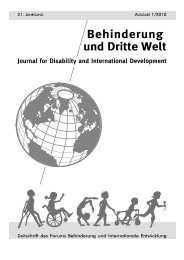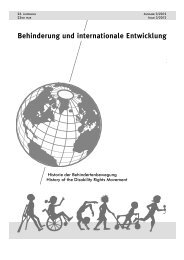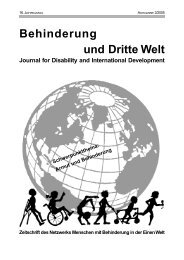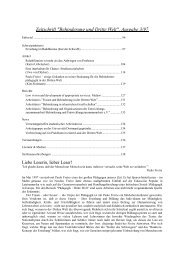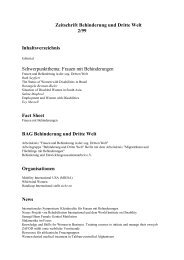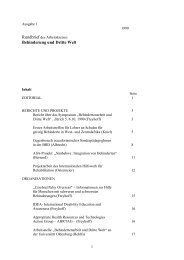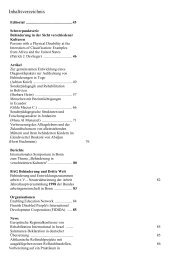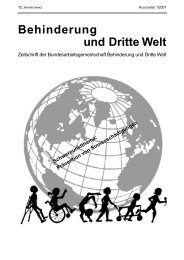Bundesarbeitsgemeinschaft Behinderung und Dritte Welt - Zeitschrift ...
Bundesarbeitsgemeinschaft Behinderung und Dritte Welt - Zeitschrift ...
Bundesarbeitsgemeinschaft Behinderung und Dritte Welt - Zeitschrift ...
Sie wollen auch ein ePaper? Erhöhen Sie die Reichweite Ihrer Titel.
YUMPU macht aus Druck-PDFs automatisch weboptimierte ePaper, die Google liebt.
Introduction<br />
Deaf-blind children or children with dual sensory<br />
impairment are those having a combination of<br />
sight and hearing impairments but are not necessarily<br />
totally blind or profo<strong>und</strong>ly deaf. Some of these<br />
children have residual hearing and vision. Frequently,<br />
some of the additional handicap the deaf-blind<br />
have are physical, intellectual and behavioural disabilities.<br />
However, major problems which characterized<br />
these children are, communication difficulties,<br />
motor skills, mobility, social behaviour and cognitive<br />
limitations. Deaf-blind children may have intellectual<br />
level ranging from giftedness (as in the case<br />
of Helen Keller who at the age of sixteen lost both<br />
sight and hearing) to severe mental retardation. Due<br />
to dual impairment, these children obtain most information<br />
through secondary senses, such as, taste,<br />
touch, smell, and kineasthetic means and also by the<br />
residual hearing or sight and through indirect information<br />
supplied by others. Since communication is a<br />
major problem, a strong emphasis is laid on some<br />
form of sign language, gestures, speech, tactual and<br />
speech reading for some children who have speech<br />
ability and others use finger spelling to supplement<br />
the sign language. Daily living skills, such as, bathing,<br />
washing, dressing, cooking, communication,<br />
moving aro<strong>und</strong> one’s own environment in addition<br />
to vocational training are some of the important<br />
skills deaf-blind people learn.<br />
Deaf-blind education in Ghana<br />
In Ghana, deaf-blind education started on 10th January, 1978 at Mampong-Akwapong in the<br />
Eastern Region (Gadagbui 1998). It began with Ms.<br />
Marion Obeng a teacher of the deaf who was interested<br />
in a boy who was deaf and blind at the same<br />
time and had some traces of mental retardation. She<br />
sought help and both of them had the opportunity to<br />
get to Perkins school for the blind in Water town in<br />
the United States (Avoke 1997). After two years they<br />
both came back and with financial support from the<br />
Christoffel-Blind–Mission (CBM) <strong>und</strong>er Mrs. Angelika<br />
Zehlz, a one classroom block, a bore-hole<br />
pump, hearing aids and Volkswagen pick-up were<br />
103<br />
<strong>Zeitschrift</strong> <strong>Behinderung</strong> <strong>und</strong> <strong>Dritte</strong> <strong>Welt</strong> 3/2001<br />
ARTIKEL<br />
Deaf-blind education: a case study in Mampong-Akwapim in Ghana<br />
Grace Yawo Gadagbui<br />
Deaf-blind education in Ghana is 23 years old. Survey carried out through questionnaire, interview and observations<br />
indicate that methods of reading is based on one-to-one approach. Life skills, vocational training, communication skills,<br />
orientation and mobility, sensory training are courses run among others using multi-sensory approach. Local dishes,<br />
door and table mats, mufflers and fluffy balls are practical work the children prepare. In addition, the article spells out<br />
suggestions to problems and employment.<br />
acquired. In addition the CBM sponsored a teacher<br />
to an international course in the Netherlands. The<br />
government of Ghana trains teachers, pays their<br />
salaries, and provides boarding and lodging for the<br />
children. To supplement the government’s aid, CBM<br />
is still giving financial support, equipment and materials<br />
for teaching and learning. This is also complemented<br />
by World Vision International, Ghana<br />
branch.<br />
Admission is by assessment in any of the assessment<br />
centres in the country. The centre has been active<br />
with workers, workshops for parents and as a place<br />
of attraction for visitors appreciation of how teachers<br />
shape the lives of these children to be independent.<br />
Nevertheless, the deaf-blind department is the least<br />
developed of the special schools in Ghana. It is not<br />
autonomous but <strong>und</strong>er the administration of the<br />
demonstration school for the deaf at Mampong-<br />
Akwapim. To create awareness of the activities of<br />
the deaf-blind programme in the department, a survey<br />
was carried out from 1 st of February to 16 th<br />
February 2001 on the school.<br />
Objectives<br />
The aims were three folds:<br />
i) To identify the strengths of the children’s functioning<br />
capabilities.<br />
ii) To project and promote deaf-blind awareness to<br />
the public.<br />
iii)To determine the need to focus attention in training<br />
teachers for deaf-blind education in the<br />
country.<br />
Methodology<br />
Population<br />
Teachers of the deaf-blind and deaf-blind children<br />
participated in the study.<br />
Sample<br />
Seventeen participants were involved. Seven teachers<br />
made up five females and two males including<br />
103



